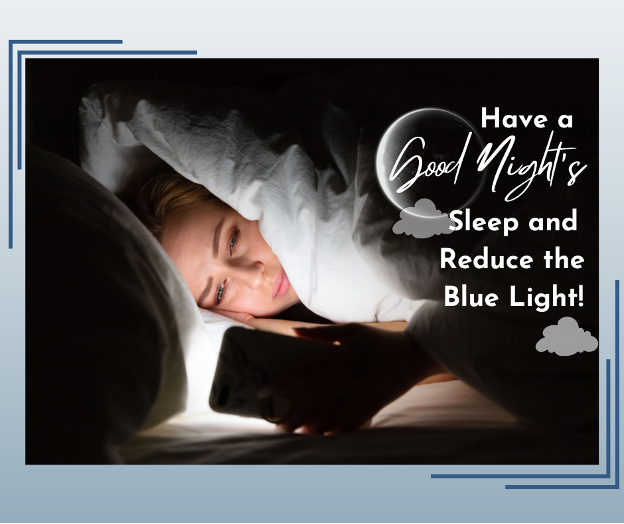Home » Blog » Have a Good Night’s Sleep and Reduce the Blue Light!
Have a Good Night’s Sleep and Reduce the Blue Light!
Posted by: Georgia Center for Sight

The blue light from your digital devices may prevent you from falling asleep and having a quality night’s sleep. You may have experienced trouble falling asleep after staring at your phone or other digital devices before bedtime. The blue light from your digital devices keeps you up and stimulates you to wake up, whether from exposure to sunlight or the screens of your digital devices.
According to a study from Molecular Vision, blue light has been proven to affect the body’s circadian rhythm, natural sleep, and wake cycle. Limiting screen time to one to two hours before bed and using night mode on electronic devices are excellent habits to adopt to minimize blue light exposure, which can affect our ability to fall asleep.
Night Mode Can Help Reduce Blue Light
According to the American Academy of Ophthalmology, dark mode, or night mode, is a setting offered on various digital devices to decrease the screen brightness while reducing eye strain. This feature, which shifts lighter colors toward pink and red instead of blue, is a boon for those struggling with digital eye strain. The variations of contrast and colors used in the night mode reduce glare and help our eyes adjust easily to surrounding light, leading to less eye strain and easier, comfortable reading. Decreasing your exposure to blue light and limiting screen time and brightness allows you to sleep better and feel more relaxed.
Digital Eye Strain Signs and Symptoms
One symptom of digital eye strain is trouble falling asleep after viewing your digital devices before bed. Below are signs of digital eye strain that can affect your workday if you do not take frequent breaks.
- Sore, tired, burning, or itching eyes.
- Watery or dry eyes.
- Blurred or double vision.
- Headache
- Neck and Shoulder Pain
- Feeling that you cannot keep your eyes open.
It’s important to remember that you have the power to minimize the symptoms of digital eye strain. The 20-20-20 rule is a simple yet effective tool that you can use to take control of your eye health. By setting your phone timer to remind you to look away every 20 minutes at an object that is about 20 feet away for a full 20 seconds, you can significantly reduce the strain on your eyes and feel more comfortable during your screen time. Empower yourself with this simple yet effective strategy to alleviate digital eye strain.
How Is Digital Eye Strain Treated?
One of the simplest ways to avoid sleep disruption and digital eye strain is to turn on night mode on your iPhone or Android devices. This small adjustment can bring significant relief to your eyes and help you maintain good eye health. To recharge your body and ensure a restful night’s sleep, consider putting down your digital device one to two hours before bed. If you must catch up on your favorite TV show or read on your digital device during bedtime hours, switch to the night mode settings to eliminate eye strain and enjoy a more comfortable viewing experience.
Solutions to digital screen-related eye problems vary. However, they can usually be alleviated by obtaining regular eye care and changing habits in how you view your digital screen.
If you continue to suffer from digital eye strain or have any discomfort with your eyes, it’s important to remember that professional help is always available. You’re not alone in this. Don’t hesitate to call us today to schedule an appointment. Your eye health is our priority, and we’re here to help you see clearly and comfortably. We’re just a phone call away, ready to provide the support and care you need.
Sleep Tight and Turn Down the Blue Light! Embrace the peacefulness of the night and give your eyes a break for a restful slumber.
Sweet dreams await!

